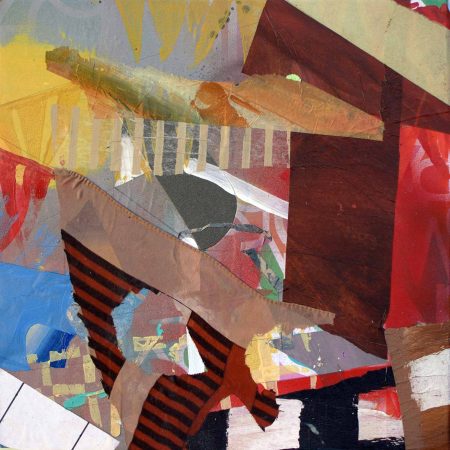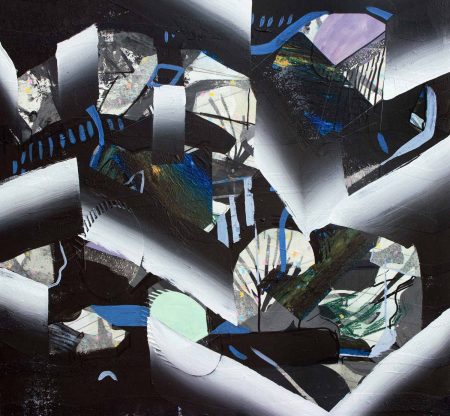Sara Willadsen’s Less Gloom opened at the Rockford University Art Gallery on March twentieth and closed on April twenty-second. I have admired Sara’s work from afar, through the byways of social media for some time now, and I just can’t stay away from it any more. I have admired the work without understanding it apparently. The particular body of work presented in this exhibition is culled from a period of three months spent at Willadsen’s home in Sheboygan Falls, WI and then also at a two-week long residency at Taleamor Park near LaPorte, IN. Most of Willadsen’s work deals with the immediacy of space and is made through tangential flutter of carefully compiled collage material, interesting mark making techniques, and immediate action centered around a geographically rhetorical conversation concerning form and lived experience, which I imagine must be both a compulsory and sort of self-spiritual process for Willadsen. I sent the artist a series of questions about the work. As I had started trying to digest her imagery, I felt more and more like I wasn’t getting the point. I had to know more and decided to ask Sara some questions directly.
JA: How are your titles informed?
SW: Similar to my ongoing collection of collage materials, my titles typically come from a list of words and sayings I have kept (and still continuously add to) for the last four years. These are phrases I read in books or hear in conversations with others that initially sound ridiculous or have a very specific context. I hold on to them because I feel they could potentially relate to my individual experience and aid in communicating my inner thoughts and feelings to my audience in the future.
After I finish a piece and have some time to process it visually, I go to this list and see if anything on it feels right for the work at that moment in time. If nothing really fits, I like to use simple, nondescript words that get recycled every so often (just with a new number after it).
JA: With paintings like Field, Field 2, and Field 3 how relative is subject? Does it maintain real continuity?
SW: Subject is somewhat relative. As far as these specific paintings go, I created Field, Field 2, and Field 3 during my two week residency on a farm at Taleamor Park in LaPorte, Indiana, and pulled (literally) from much of the same collage materials and paint palettes to construct them. They are all originating from my experiences, feelings, and interactions in this particular physical space and are consequently connected in that way.
I consider all of my work thus far as part of a continuing series of landscapes and interiors which allow me to appease my curiosity in materials and formal elements such as color and composition while simultaneously constructing invented spaces. While my material choices and formal interests have transformed over the last couple years, my desire to create environments that help me process my experiences and emotions still remains.

Top: Sara Willadsen, Field 2, mixed media on panel, 8” x 10”, 2016.
Bottom: Sara Willadsen, Revisiting 2, mixed media on panel, 14” x 16”, 2017.
Work that has a nonspecific title such as Field and those that follow (Field 2, Field 3, and so on) were created in that order. They are motivated by fleeting memories I recall at that exact time of production. Since they are so momentary, giving them a title more specific than that feels unfair.
JA: When you refer to “native shapes” how literal is that?
SW: This is a fairly literal description. A good example can be found in LaPorte. During my numerous walks at Taleamor Park last autumn, I studied various plants and trees found on the property and collected many fallen leaves for my studio. The shapes and textures of these leaves prompted me to cut identical shapes out of collage material to adhere to this piece. The material left with negative spaces after cutting these out was also used on other works such as Recording 1 and Focus Pulls.
Another method I used to replicate natural and architectural patterns I encountered last summer and around the Taleamor property was by making foam stamps modeled after these shapes and printing those on tissue paper and the pieces themselves. Many stripes, grids, and other patterns referencing buildings were executed with this technique.
I also utilized some of the objects I found on and off the LaPorte property to print patterns on my pieces. This included the use of osage oranges that left spotty, lacy configurations, as well as corn cobs, whose more subtle texture can be seen in LaPorte.
JA: What is the goal of your game? If you’re mapping visual relationships viewed in real world structures and environments, to what end are you recreating these through your own language? How does this language percolate or permutate across different surfaces?
SW: Even with my numerous real world references, fragments of these structures and environments are dissected and mixed together to make up new, unrecognizable spaces that my visual language dictates every time I work. This language is very fluid in that it feels like it is constantly changing and adapting to new ideas. This is evident in my latest pieces, Mounds 1, Mounds 2, and Untitled (the smaller, irregularly shaped piece). The idea for these soft paintings is new to my studio practice and is still in a very experimental stage. The application process for painting and collaging onto these and other unique surfaces remains similar to my two-dimensional work in that I use the existing shapes as prompts. This might change in the future, however, as I continue to explore this curved surface further and experiment with other shapes and textures.
JA: Do you make rules?
SW: I do make rules when working. I find that this is the most helpful way for me to grow (aesthetically) as a visual artist. For example, I tend to gravitate towards the same colors, patterns, and other elements. I don’t necessarily think this is bad, but by pushing myself to use a color combination that I initially dislike for a prompt, it usually becomes something I’m most proud of making at that moment.
One important rule I followed for the majority of this work in was to stop working on each piece about two or three steps before I thought it was complete. I have a tendency when working to layer too much paint and material until a piece gets too busy and loses the initial fresh, natural feeling to it that was motivating its creation in the first place. This rule has helped me gain confidence in my intuitive process, to be more contemplative with my work, and to overall create what I think best captures my thoughts and emotions that I find hard to communicate by other means.
JA: In your process how does sensation fit in? I am posing this with reference to some of your titling (i.e. The Witching Hour, Gnip Gnop) which at times seems to provide sensation more directly than the work might on its own. I am also wondering how sensation guides the picture itself.
SW: As I mentioned earlier, some of my titles are more striking than others but all pieces are created in the same manner. My working process when I am building up a piece is all about personal sensation. I work intuitively and quickly because I don’t want to lose what I am feeling at that particular time. I strive to get it all down visually as a mental release for myself and as a visual form of communication to my audience. Communicating in this way doesn’t always allow for titles with such excitement tied to them, but when it does I think it can really strengthen the mood of the piece.
-Jack Wood






